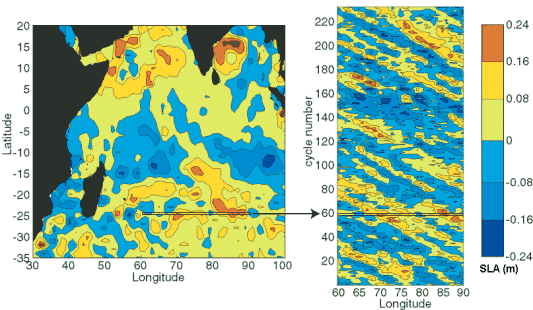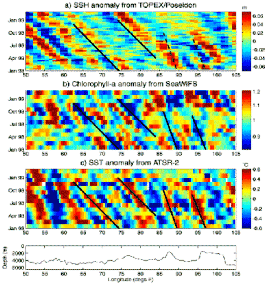Planetary waves : Rossby and Kelvin waves
Though the large currents are very important, the ocean and climate are also influenced by phenomena that are harder to see. "Planetary" waves cross the oceans along parallels and interact with general oceanic circulation. These are either Rossby waves, which go from East to West or Kelvin waves which move in the opposite direction. They intensify currents such as the Gulf Stream or the Kuroshio. In addition, they may be reflected off the continents and return in the opposite direction, or follow coastlines. These waves and their reflections play a key role, in particular in the El Niño phenomenon.

Rossby waves had been predicted theoretically for over 50 years, but could not be observed until the advent of altimetric satellites. Their small amplitude (a few centimetres), their extent (an ocean basin) and their velocity (a few kilometres per day - they take several years to cross the Pacific Ocean at 30° latitude) made it nearly impossible to observe them with in situ measurements. Now that we know what we are looking for, we can also detect them in other kinds of satellite measurements. High precision altimetry, however, remains the best way of detecting these waves.
Further information :
- Image of the month, February 2000 : Waves across the water.
- Lively Data, November 24, 2003 : A temporal slice.
- Newsletter #6, 1998 : Equatorial waves and warm pool displacement in 1992-1996. T.Delcroix et al.
- Newsletter #8, 2001 : Low-frequency sea level variability in the Atlantic, Indian and Southern Oceans. R. Morrow.
- Newsletter #8, 2001 : Low-Frequency variability in the Southeastern Pacific. A. Vega.
- external site : Waves the size of the ocean (Museums teaching planet Earth).





